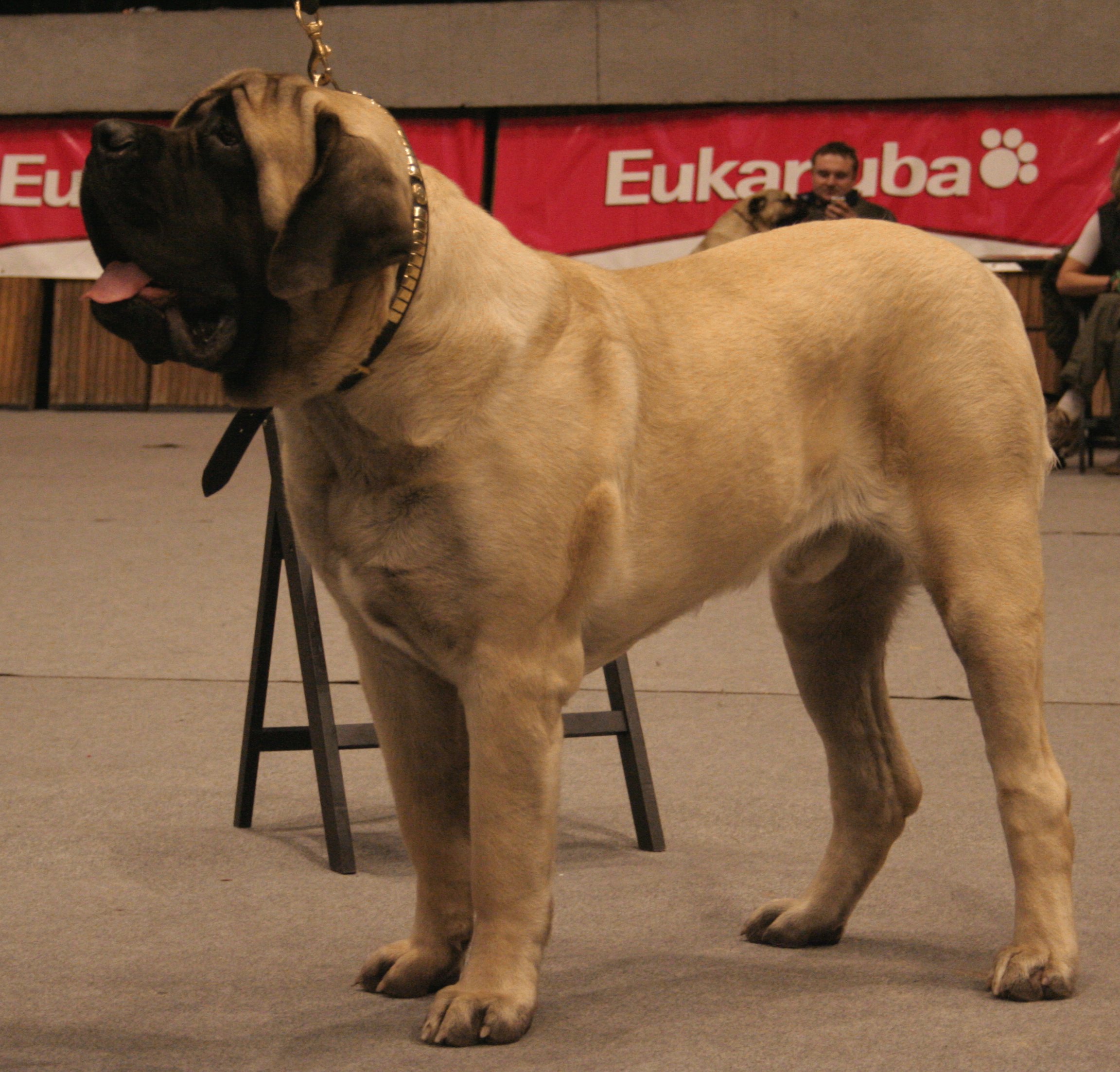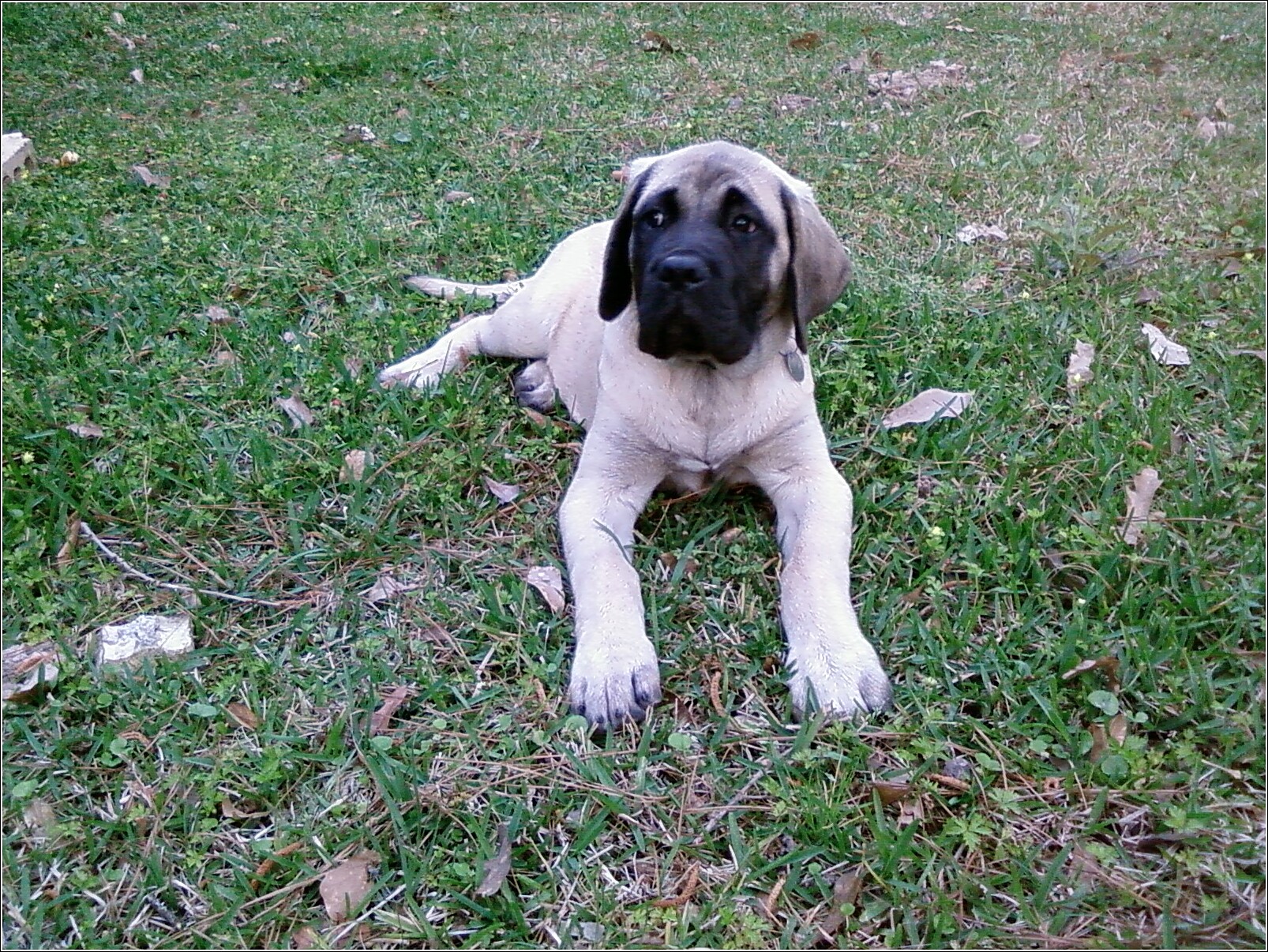
The Old English Mastiff is an ancient breed with a rich history that dates back to the Roman Empire. They were originally bred as guard dogs and war dogs.
Their massive size is a result of selective breeding over the centuries, with some males weighing up to 230 pounds.
These gentle giants are known for their calm and gentle nature, making them a great companion for families with children.
Physical Characteristics
The old English mastiff is a massive dog, with males weighing in at 160-230 pounds and females at 120-170 pounds. Their height is equally impressive, with males reaching at least 30 inches and females at least 27.5 inches at the shoulder.
Their muscular build is balanced by a natural cuteness, with a wrinkled brow, droopy jowls, and a propensity for drooling. Their coat is short and sheds occasionally, but is easy to maintain.
The mastiff's colors can be fawn, apricot, or brindle, with a dark muzzle, ears, and nose, and brown eyes.
Appearance
The English mastiff is an enormous dog, with some males weighing over 200 pounds, as Dr. Scott Neabore, a veterinarian, has seen firsthand.
Their massive size is evident in their height, with females standing at least 27.5 inches at the shoulder and males at least 30 inches.
The breed standard doesn't specify a maximum height, but rather focuses on the minimum requirements.
Males can weigh anywhere from 160 to 230 pounds, while females weigh between 120 and 170 pounds.
The mastiff's muscular build is balanced by a natural cuteness, with their wrinkled brow, droopy jowls, and tendency to drool.
Their coat is short and sheds occasionally, but is relatively easy to maintain.
Characteristics
Mastiffs are truly gentle giants, known for their kind souls and calm demeanor. They make great family pets due to their affectionate and family-friendly nature.
Their size requires a decent amount of care, but they reward their humans with a lifetime of affection and companionship. They have a high affection level and are always happy to be around their family.
Mastiffs are not the best fit for homes with multiple pets, as they have a low pet-friendliness rating. They need plenty of exercise, with high exercise needs that should be met through regular walks and playtime.
Their energy level is medium, which means they need some exercise but can also adapt to a relatively calm lifestyle. They have a high playfulness rating, so be prepared for plenty of fun and games.
Mastiffs are not the easiest dogs to train, with a low trainability rating. They are also relatively low in intelligence, which can make training a bit more challenging.
Here's a summary of their key characteristics:
Temperament and Behavior
Old English Mastiffs are known for their gentle and loyal nature, making them an excellent family pet. They are also natural protectors, but this can be tempered with proper socialization.
Mastiffs are intelligent and sensitive, responding best to kindness, consistency, and positive reinforcement during training. Harsh words or corrections can be detrimental to their development.
With their large size comes a need for supervision around children, as they may accidentally be stepped on. However, with proper care and attention, Mastiffs can thrive in families with kids.
Here are some key traits to consider:
- Gentle and loyal
- Protective
- Become endearingly lazy as they age
Temperament
Mastiffs are known for their loyal nature, making them excellent family pets. They're also good-natured and eager to please, which is a great combination for a family dog.
Their gentle side is especially important to note, as they're gentle with children, but it's still crucial to supervise interactions between little kids and these large dogs.
Mastiffs are intelligent and sensitive, so they respond best to kindness, consistency, and positive reinforcement when training.
They tend to get along with cats and other dogs, especially if introduced at a young age. Neabore notes that responsible breeders often prioritize breeding for a good temperament.
Mastiffs can be a bit aloof towards strangers, but they're friendly and demonstrative towards family members. They may even try to be lapdogs, which is a testament to their affectionate nature.
As they age, mastiffs become endearingly lazy, which is a great trait for families with young children. However, their size and strength can still be overwhelming, making them less suitable for families with very young kids or the elderly.
Here are some key traits of a mastiff's temperament:
- Gentle
- Loyal
- Affectionate
- Intelligent
- Sensitive
- Protective
Training
Training is crucial for mastiffs, especially because of their giant size.
Proper training and socialization are essential to prevent jumping and leash-pulling.
Socialization is key to help your mastiff's natural protectiveness be appropriate, rather than overprotective around visitors.
You should provide plenty of durable chew toys to save your furniture, as mastiffs like to chew on things.
Their strong tail can sweep items off tables, so dog-proofing your home is a must.
Care and Maintenance
The Old English Mastiff needs regular care and attention to stay happy and healthy. They require a large area to stretch out and sleep, preferably on soft bedding to prevent painful callouses and bursitis.
Their size also means they need a large vehicle for travel, and their drool is a constant feature that can be messy. They're not a good choice for fastidious housekeepers.
To keep them cool, it's essential to provide air-conditioned spaces during warm weather, as their large body mass makes them susceptible to overheating. Regular exercise is also crucial, with about an hour of interactive playing or walking each day recommended.
Care

The Mastiff's size is the major challenge to its upkeep, requiring a large area to stretch out and sleep on soft bedding to avoid painful callouses and bursitis.
To prevent overheating, it's essential to keep your Mastiff in air-conditioned spaces during warm weather, as its large body mass and short nasal passages make it susceptible to overheating.
A daily hour of interactive playing or walking is necessary, but be aware that they're not excessively active and can get bored if the session goes too long.
Mastiffs are quite docile, but younger dogs are more playful, and an endearing quality of aloof laziness often develops as they mature.
To keep your Mastiff fit and motivated, aim to let them play and exercise for at least 30-60 minutes or more each day, even if split into multiple sessions.
They do very well indoors, even in an apartment, or a house with a fenced yard, but consider the stairs if your living space requires climbing.

Mastiffs can be couch potatoes, but they benefit from walks and are perfectly content to curl up on the furniture within view of their owner.
Because they're prone to developing joint issues, the ideal living space has limited or no stairs, and they should avoid excessive running, jumping, and long walks in their early years.
Mastiffs are not good with time spent alone and prefer to be with their family, enjoying time spent with other household pets as well.
Keep plenty of towels nearby to deal with their constant drooling, and steel yourself for a deluge of spit that will cover floors, walls, and ceilings when they shake their head.
Mastiffs learn best through short training sessions filled with positivity, praise, and treats, and their short coats require minimal grooming, only needing to be brushed a couple of times a week.
The wrinkles around their head and face may need cleaning, and regular nail trims and teeth cleanings are also necessary.
Mastiffs are not considered particularly intelligent or trainable, but some light obedience training is still a good idea to ensure they remain safe and good companions.
Worth a look: Bull Terrier Head Shape

To ensure your Mastiff gets the nutrition they need, choose a high-quality food for large breeds and work with a veterinarian if you need guidance.
Feed a Mastiff puppy food specific to large breeds to help them grow steadily and not too fast, reducing the risk of adult-onset hip dysplasia.
Adult Mastiffs need 6-8 cups of dry food each day, split into two meals to prevent bloating and stomach torsion, and monitor their weight gain and discuss it with your veterinarian.
Mastiffs are sloppy drinkers, so provide clean, fresh water at different points of the day, and they're prone to passing gas.
The Mastiff's short coat typically needs little more than routine grooming, including regular brushing, bathing, and nail trimming.
Check their ears and eyes often for signs of irritation or infection and clean them gently whenever necessary, keeping their ears and facial skin folds clean and dry.
Mastiffs are known to salivate quite a bit, so keep drool rags handy to deal with their constant drooling.
Related reading: Best Food for English Mastiff
Cons

Taking care of a Mastiff can be a big responsibility, and it's essential to consider the potential downsides.
Drooling is a significant issue with Mastiffs - they can produce a lot of saliva, which can be messy and require frequent cleaning.
Their large tails can be a problem too - they can cause damage to furniture and other objects, and may require extra space in your home to accommodate their size.
Mastiffs are also heavy chewers, which means they can easily damage shoes, furniture, and other items if they're not provided with plenty of chew toys.
To minimize the damage, make sure to provide your Mastiff with plenty of chew toys and keep an eye on them at all times.
Here are some specific things to be aware of:
- Drool quite a bit
- Large tails can cause damage and require extra space in your home
- Heavy chewers
Health and Wellness
As an owner of an Old English Mastiff, you're likely aware of the breed's potential health concerns. Mastiffs are prone to joint and musculoskeletal conditions, including elbow and hip dysplasia.
Their size also makes them susceptible to heart disease, hypothyroidism, eye problems, certain cancers, and neurological issues. Gastric dilatation-volvulus (GDV) complex, or bloat, is another serious concern, which can be life-threatening if not treated promptly.
To reduce the risk of bloat, your veterinarian may recommend a procedure called gastropexy. This involves suturing the outer wall of the stomach to the body wall, preventing it from twisting.
A shorter lifespan is also a reality for Mastiffs, averaging 6-10 years. This is due to their size and medical challenges, so it's essential to be prepared for a shorter life span.
Responsible breeding practices can help minimize the risk of inherited health problems. However, some common issues include hip and elbow dysplasia, gastric dilatation-volvulus, elbow hygroma, cancer, and eye issues.
Here are some specific health concerns to be aware of:
- Hip and elbow dysplasia: Inherited orthopedic conditions that can worsen with age.
- Gastric dilatation-volvulus: Bloating that can be life-threatening if not treated promptly.
- Elbow hygroma: A painless, fluid-filled swelling that can grow over time.
- Cancer: A leading cause of death in Mastiffs, with common types including lymphoma, osteosarcoma, mast cell tumors, and hemangiosarcoma.
- Eye issues: Mastiffs are prone to various eye problems, including ectropion, entropion, distichiasis, cataracts, progressive retinal atrophy (PRA), persistent pupillary membranes (PPM), retinal dysplasia, and macroblepharon.
To ensure your Mastiff lives a long and healthy life, it's crucial to maintain a healthy weight. Obesity can exacerbate other health conditions and shorten their lifespan. Regular veterinary check-ups and a balanced diet can help prevent or manage these issues.
You might enjoy: Healthy Bull Terrier
Frequently Asked Questions
What is the average lifespan of an Old English Mastiff?
The average lifespan of an Old English Mastiff is 6-10 years. With proper care, they can live a relatively short but loving life.
How much do English Mastiffs cost?
English Mastiffs typically cost between $1,500 to $4,000, depending on the breeder and location. Researching a reputable breeder is crucial to ensure you're getting a healthy puppy.
Featured Images: pexels.com


